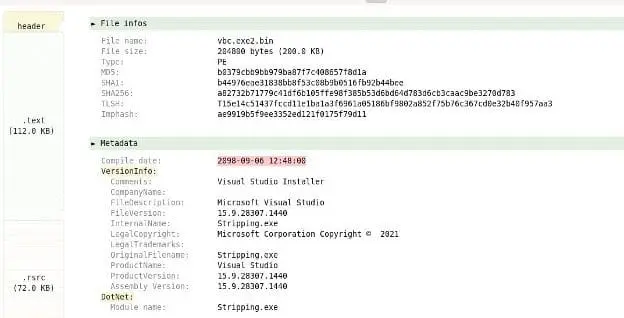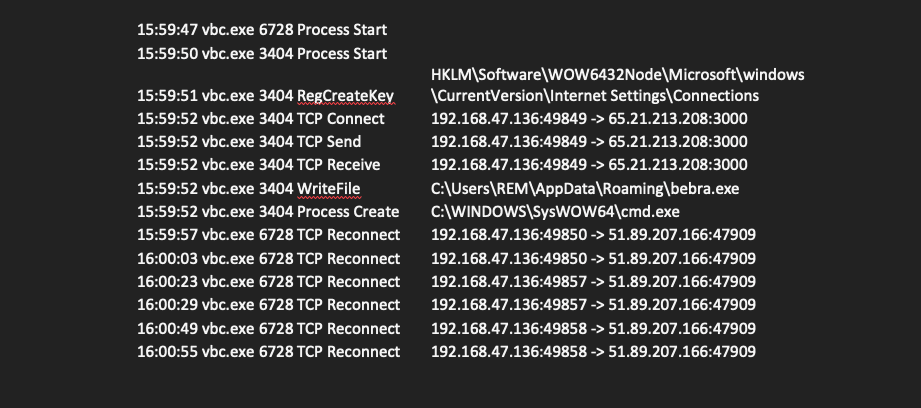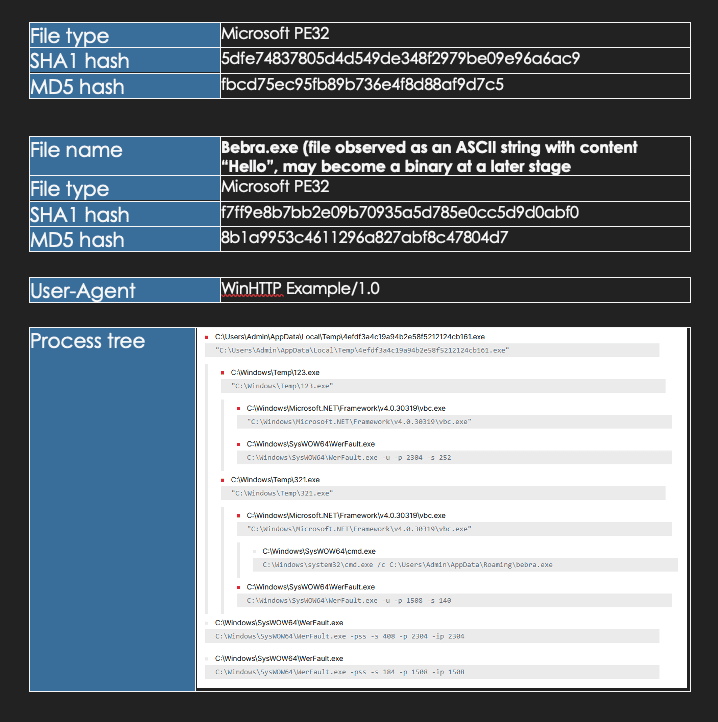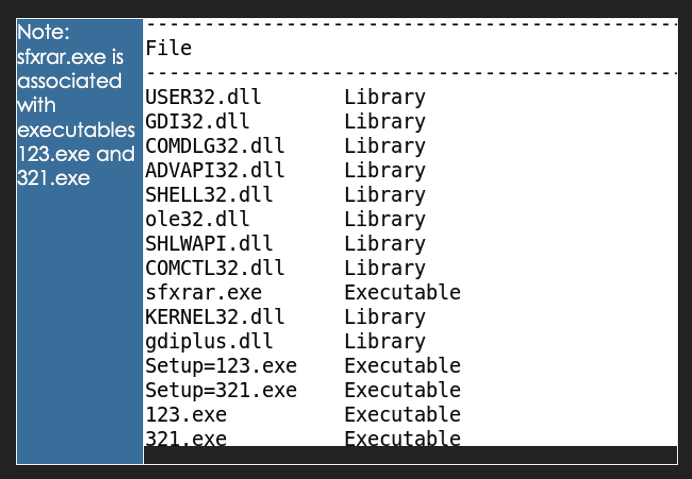I. Targeted Entities
- Opportunistic (any industry)
II. Introduction
RedLine Stealer is a malware family written in C# that harvests autocomplete data, such as saved credentials and financial information, from web browsers. It can also steal system information such as location, hardware configuration, and security software data.
III. Background Information
Redline Stealer (RLS) is a popular piece of malware that operates on a malware-as-a-service (MaaS) model and is sold through underground forums for approximately $100 (Unnikrishnan). Cyber criminals are able to use this software to gather a vast range of sensitive data from Gecko-based and Chromium-based web browsers. This data includes saved credentials, financial information, and cookies, which allow attackers to access various accounts ranging from social media to cryptocurrency wallets (Meskauskas).
Telemetry data, collected by CloudSEK, has picked up deployment of RLS via Regsvcs.exe on Windows systems. The content of the Regsvcs.exe process, in suspended state, is replaced by the loader using a process hollowing technique. This allows for the portable executable of RLS to be mapped into the Regsvcs.exe process, where thread contexts can be manipulated to point to RLS’s entry location. Once complete, RLS is able to masquerade as a legitimate process on the system (Unnikrishnan).
Fake software posing as legitimate software is often used to spread malware like RLS, and eSentire’s Threat Response Unit (eTRU) has observed such a case where RLS is being distributed via a fake version of AnyDesk (eSentire). The legitimate version of AnyDesk’s website was copied to a malicious website, where a victim would download an installer as an ISO image file that has been padded with junk data. This padding is done to bypass file size limitations imposed by sandboxes and antiviruses (eSentire). Once the victim runs the installer, several commands are executed to run obfuscated files that check for antivirus software, communicate with the attacker’s command-and-control servers, and read the victim’s data (eSentire).
RLS comes with several more features other than stealing data like saved passwords. Its primary targets are the user’s desktop and documents directories, where it looks for cryptocurrency data, like crypto wallets, through more than 40 browser extensions. It captures a screenshot of the desktop, as well as collects Discord tokens and user data from the Steam. Beyond financial data, RLS can retrieve system information such as username, processor and memory information, installed browsers and antivirus programs, and currently running processes (Unnikrishnan).
IV. Cyber Florida SOC Operations
After initial malware execution, Cyber Florida has observed multiple executables dropped by a self-extracting RAR file. These executables, 123.exe and 321.exe work together to create two vbc.exe child processes to carry out the malicious code. The process vbc.exe appears to attempt communication with targeted IP addresses and ports and with one of those communications, Cyber Florida observed what appeared to be the creation of “bebra.exe” but upon a hex content review of the file, only the ASCII string “Hello” was present. It is suspected that this process may be attempting to establish some sort of communication and then leads to a program crash by design. A hypothesis is that the “bebra.exe” file may just be a place holder until actual binary content is needed or wanted by the malware. A review of vbc.exe appears to be a legitimate binary that may have been abused and injected into. Vbc.exe is known as the Visual Basic Compiler and used with the .Net Framework. The tactic of injecting into a known good process may be a way for an attacker’s malware to evade detection. The vbc.exe processes did have portions of memory that had RWX (Read, Write, and Execute) permissions. These sections of memory did have binary content and those were extracted and analyzed. Cyber Florida uploaded both files to VirusTotal and the following binary file was already detected:
However, the following was not seen on VirusTotal until Cyber Florida uploaded the file for review:
https://www.virustotal.com/gui/file/f179a2d8bc7ab6cd32a8c1f95988d77fb1381072ac92f099047f7395cae84115
Network Traffic
This communication was the first observed network connection from the victim system to a potential attacker-controlled system. The communication was to 65.21.213.208:3000. The TCP stream below shows a POST action to the system with no real content. The server replies back with a “Hello” response. Of interest the “bebra.exe” file identified in the victim’s AppData/Roaming folder was not a binary of any sort and when viewed in a hex editor only had an ASCII string of “Hello”. Also, of interest with “bebra.exe” is that the Content-Type was of application/x-msdownload, which would be associated with a binary file.

The following communication was the second observed network connection from the victim system to a potential attacker-controlled system. The traffic was to 51.89.207.166:47909. The observed traffic appeared to have no successful connections made. However, this IP and specified port have been identified as potentially malicious through other threat intelligence sources.

Similar Observations Seen From ArechClient2
In November 2022, the Cyber Florida SOC released a threat advisory on Arechclient2, and provided presentations on their analysis. During analysis of Arechclient2 a Base64 string containing, once de-obfuscated, various Chrome extensions associated to Crypto wallets. Arechclient2 and RedLine appear to have similar functionality such as stealing browser data like usernames, passwords, and other related content such as information related to crypto wallets. When analyzing the current version of RedLine a similar Base64 string was found. The following string is base64 encoded data and the decoded results, via CyberChef. This further shows similarity between the two malware variants.
ZmZuYmVsZmRvZWlvaGVua2ppYm5tYWRqaWVoamhhamJ8WW9yb2lXYWxsZXQKaWJuZWpkZmptbWtwY25scGVia2xtbmtvZW9paG9mZWN8VHJvbmxpbmsKamJkY
W9jbmVpaWlubWpiamxnYWxoY2VsZ2Jlam1uaWR8TmlmdHlXYWxsZXQKbmtiaWhmYmVvZ2FlYW9laGxlZm5rb2RiZWZncGdrbm58TWV0YW1hc2sKYWZiY2JqcGJwZm
FkbGttaG1jbGhrZWVvZG1hbWNmbGN8TWF0aFdhbGxldApobmZhbmtub2NmZW9mYmRkZ2Npam5taG5mbmtkbmFhZHxDb2luYmFzZQpmaGJvaGltYWVsYm9ocGpiY
mxkY25nY25hcG5kb2RqcHxCaW5hbmNlQ2hhaW4Kb2RiZnBlZWloZGtiaWhtb3BrYmptb29uZmFubGJmY2x8QnJhdmVXYWxsZXQKaHBnbGZoZ2ZuaGJncGpkZW5qZ21
kZ29laWFwcGFmbG58R3VhcmRhV2FsbGV0CmJsbmllaWlmZmJvaWxsa25qbmVwb2dqaGtnbm9hcGFjfEVxdWFsV2FsbGV0CmNqZWxmcGxwbGViZGpqZW5sbHBqY2J
sbWprZmNmZm5lfEpheHh4TGliZXJ0eQpmaWhrYWtmb2JrbWtqb2pwY2hwZmdjbWhmam5tbmZwaXxCaXRBcHBXYWxsZXQKa25jY2hkaWdvYmdoZW5iYmFkZG9qam
5uYW9nZnBwZmp8aVdhbGxldAphbWttamptbWZsZGRvZ21ocGpsb2ltaXBib2ZuZmppaHxXb21iYXQKZmhpbGFoZWltZ2xpZ25kZGtqZ29ma2NiZ2VraGVuYmh8QXRvbW
ljV2FsbGV0Cm5sYm1ubmlqY25sZWdrampwY2ZqY2xtY2ZnZ2ZlZmRtfE1ld0N4Cm5hbmptZGtuaGtpbmlmbmtnZGNnZ2NmbmhkYWFtbW1qfEd1aWxkV2FsbGV0Cm5rZ
GRnbmNkamdqZmNkZGFtZmdjbWZubGhjY25pbWlnfFNhdHVybldhbGxldApmbmpobWtoaG1rYmpra2FibmRjbm5vZ2Fnb2dibmVlY3xSb25pbldhbGxldAphaWlmYm5iZ
m9icG1lZWtpcGhlZWlqaW1kcG5scGdwcHxUZXJyYVN0YXRpb24KZm5uZWdwaGxvYmpkcGtoZWNhcGtpampka2djamhraWJ8SGFybW9ueVdhbGxldAphZWFjaGtubWV
mcGhlcGNjaW9uYm9vaGNrb25vZWVtZ3xDb2luOThXYWxsZXQKY2dlZW9kcGZhZ2pjZWVmaWVmbG1kZnBocGxrZW5sZmt8VG9uQ3J5c3RhbApwZGFkamtma2djYWZn
YmNlaW1jcGJrYWxuZm5lcGJua3xLYXJkaWFDaGFpbgpiZm5hZWxtb21laW1obHBtZ2puam9waGhwa2tvbGpwYXxQaGFudG9tCmZoaWxhaGVpbWdsaWduZGRramdvZm
tjYmdla2hlbmJofE94eWdlbgptZ2Zma2ZiaWRpaGpwb2FvbWFqbGJnY2hkZGxpY2dwbnxQYWxpV2FsbGV0CmFvZGtrYWduYWRjYm9iZnBnZ2ZuamVvbmdlbWpiamNhfE
JvbHRYCmtwZm9wa2VsbWFwY29pcGVtZmVuZG1kY2dobmVnaW1ufExpcXVhbGl0eVdhbGxldApobWVvYm5mbmZjbWRrZGNtbGJsZ2FnbWZwZmJvaWVhZnxYZGVma
VdhbGxldApscGZjYmprbmlqcGVlaWxsaWZua2lrZ25jaWtnZmhkb3xOYW1pV2FsbGV0CmRuZ21sYmxjb2Rmb2JwZHBlY2FhZGdmYmNnZ2ZqZm5tfE1haWFyRGVGaVdh
bGxldApmZm5iZWxmZG9laW9oZW5ramlibm1hZGppZWhqaGFqYnxZb3JvaVdhbGxldAppYm5lamRmam1ta3BjbmxwZWJrbG1ua29lb2lob2ZlY3xUcm9ubGluawpqYm
Rhb2NuZWlpaW5tamJqbGdhbGhjZWxnYmVqbW5pZHxOaWZ0eVdhbGxldApua2JpaGZiZW9nYWVhb2VobGVmbmtvZGJlZmdwZ2tubnxNZXRhbWFzawphZmJjYmpw
YnBmYWRsa21obWNsaGtlZW9kbWFtY2ZsY3xNYXRoV2FsbGV0CmhuZmFua25vY2Zlb2ZiZGRnY2lqbm1obmZua2RuYWFkfENvaW5iYXNlCmZoYm9oaW1hZWxib2hwa
mJibGRjbmdjbmFwbmRvZGpwfEJpbmFuY2VDaGFpbgpvZGJmcGVlaWhka2JpaG1vcGtiam1vb25mYW5sYmZjbHxCcmF2ZVdhbGxldApocGdsZmhnZm5oYmdwamRl
bmpnbWRnb2VpYXBwYWZsbnxHdWFyZGFXYWxsZXQKYmxuaWVpaWZmYm9pbGxrbmpuZXBvZ2poa2dub2FwYWN8RXF1YWxXYWxsZXQKY2plbGZwbHBsZWJkamplb
mxscGpjYmxtamtmY2ZmbmV8SmF4eHhMaWJlcnR5CmZpaGtha2ZvYmtta2pvanBjaHBmZ2NtaGZqbm1uZnBpfEJpdEFwcFdhbGxldAprbmNjaGRpZ29iZ2hlbmJiYWRk
b2pqbm5hb2dmcHBmanxpV2FsbGV0CmFta21qam1tZmxkZG9nbWhwamxvaW1pcGJvZm5mamlofFdvbWJhdApmaGlsYWhlaW1nbGlnbmRka2pnb2ZrY2JnZWtoZW5ia
HxBdG9taWNXYWxsZXQKbmxibW5uaWpjbmxlZ2tqanBjZmpjbG1jZmdnZmVmZG18TWV3Q3gKbmFuam1ka25oa2luaWZua2dkY2dnY2ZuaGRhYW1tbWp8R3VpbGRXYW
xsZXQKbmtkZGduY2RqZ2pmY2RkYW1mZ2NtZm5saGNjbmltaWd8U2F0dXJuV2FsbGV0CmZuamhta2hobWtiamtrYWJuZGNubm9nYWdvZ2JuZWVjfFJvbmluV2FsbGV0C
mFpaWZibmJmb2JwbWVla2lwaGVlaWppbWRwbmxwZ3BwfFRlcnJhU3RhdGlvbgpmbm5lZ3BobG9iamRwa2hlY2Fwa2lqamRrZ2NqaGtpYnxIYXJtb255V2FsbGV0CmFlY
WNoa25tZWZwaGVwY2Npb25ib29oY2tvbm9lZW1nfENvaW45OFdhbGxldApjZ2Vlb2RwZmFnamNlZWZpZWZsbWRmcGhwbGtlbmxma3xUb25DcnlzdGFsCnBkYWRqa2Z
rZ2NhZmdiY2VpbWNwYmthbG5mbmVwYm5rfEthcmRpYUNoYWluCmJmbmFlbG1vbWVpbWhscG1nam5qb3BoaHBra29sanBhfFBoYW50b20KZmhpbGFoZWltZ2xpZ25
kZGtqZ29ma2NiZ2VraGVuYmh8T3h5Z2VuCm1nZmZrZmJpZGloanBvYW9tYWpsYmdjaGRkbGljZ3BufFBhbGlXYWxsZXQKYW9ka2thZ25hZGNib2JmcGdnZm5qZW9uZ
2VtamJqY2F8Qm9sdFgKa3Bmb3BrZWxtYXBjb2lwZW1mZW5kbWRjZ2huZWdpbW58TGlxdWFsaXR5V2FsbGV0CmhtZW9ibmZuZmNtZGtkY21sYmxnYWdtZnBmYm9pZ
WFmfFhkZWZpV2FsbGV0CmxwZmNiamtuaWpwZWVpbGxpZm5raWtnbmNpa2dmaGRvfE5hbWlXYWxsZXQKZG5nbWxibGNvZGZvYnBkcGVjYWFkZ2ZiY2dnZmpmbm18
TWFpYXJEZUZpV2FsbGV0CmJoZ2hvYW1hcGNkcGJvaHBoaWdvb29hZGRpbnBrYmFpfEF1dGhlbnRpY2F0b3IKb29ramxia2lpamluaHBtbmpmZmNvZmpvbmJmYmdhb2
N8VGVtcGxlV2FsbGV0
ffnbelfdoeiohenkjibnmadjiehjhajb|YoroiWallet
ibnejdfjmmkpcnlpebklmnkoeoihofec|Tronlink
jbdaocneiiinmjbjlgalhcelgbejmnid|NiftyWallet
nkbihfbeogaeaoehlefnkodbefgpgknn|Metamask
afbcbjpbpfadlkmhmclhkeeodmamcflc|MathWallet
hnfanknocfeofbddgcijnmhnfnkdnaad|Coinbase
fhbohimaelbohpjbbldcngcnapndodjp|BinanceChain
odbfpeeihdkbihmopkbjmoonfanlbfcl|BraveWallet
hpglfhgfnhbgpjdenjgmdgoeiappafln|GuardaWallet
blnieiiffboillknjnepogjhkgnoapac|EqualWallet
cjelfplplebdjjenllpjcblmjkfcffne|JaxxxLiberty
fihkakfobkmkjojpchpfgcmhfjnmnfpi|BitAppWallet
kncchdigobghenbbaddojjnnaogfppfj|iWallet
amkmjjmmflddogmhpjloimipbofnfjih|Wombat
fhilaheimglignddkjgofkcbgekhenbh|AtomicWallet
nlbmnnijcnlegkjjpcfjclmcfggfefdm|MewCx
nanjmdknhkinifnkgdcggcfnhdaammmj|GuildWallet
nkddgncdjgjfcddamfgcmfnlhccnimig|SaturnWallet
fnjhmkhhmkbjkkabndcnnogagogbneec|RoninWallet
aiifbnbfobpmeekipheeijimdpnlpgpp|TerraStation
fnnegphlobjdpkhecapkijjdkgcjhkib|HarmonyWallet
aeachknmefphepccionboohckonoeemg|Coin98Wallet
cgeeodpfagjceefieflmdfphplkenlfk|TonCrystal
pdadjkfkgcafgbceimcpbkalnfnepbnk|KardiaChain
bfnaelmomeimhlpmgjnjophhpkkoljpa|Phantom
fhilaheimglignddkjgofkcbgekhenbh|Oxygen
mgffkfbidihjpoaomajlbgchddlicgpn|PaliWallet
aodkkagnadcbobfpggfnjeongemjbjca|BoltX
kpfopkelmapcoipemfendmdcghnegimn|LiqualityWallet
hmeobnfnfcmdkdcmlblgagmfpfboieaf|XdefiWallet
lpfcbjknijpeeillifnkikgncikgfhdo|NamiWallet
dngmlblcodfobpdpecaadgfbcggfjfnm|MaiarDeFiWallet
ffnbelfdoeiohenkjibnmadjiehjhajb|YoroiWallet
ibnejdfjmmkpcnlpebklmnkoeoihofec|Tronlink
jbdaocneiiinmjbjlgalhcelgbejmnid|NiftyWallet
nkbihfbeogaeaoehlefnkodbefgpgknn|Metamask
afbcbjpbpfadlkmhmclhkeeodmamcflc|MathWallet
hnfanknocfeofbddgcijnmhnfnkdnaad|Coinbase
fhbohimaelbohpjbbldcngcnapndodjp|BinanceChain
odbfpeeihdkbihmopkbjmoonfanlbfcl|BraveWallet
hpglfhgfnhbgpjdenjgmdgoeiappafln|GuardaWallet
blnieiiffboillknjnepogjhkgnoapac|EqualWallet
cjelfplplebdjjenllpjcblmjkfcffne|JaxxxLiberty
fihkakfobkmkjojpchpfgcmhfjnmnfpi|BitAppWallet
kncchdigobghenbbaddojjnnaogfppfj|iWallet
amkmjjmmflddogmhpjloimipbofnfjih|Wombat
fhilaheimglignddkjgofkcbgekhenbh|AtomicWallet
nlbmnnijcnlegkjjpcfjclmcfggfefdm|MewCx
nanjmdknhkinifnkgdcggcfnhdaammmj|GuildWallet
nkddgncdjgjfcddamfgcmfnlhccnimig|SaturnWallet
fnjhmkhhmkbjkkabndcnnogagogbneec|RoninWallet
aiifbnbfobpmeekipheeijimdpnlpgpp|TerraStation
fnnegphlobjdpkhecapkijjdkgcjhkib|HarmonyWallet
aeachknmefphepccionboohckonoeemg|Coin98Wallet
cgeeodpfagjceefieflmdfphplkenlfk|TonCrystal
pdadjkfkgcafgbceimcpbkalnfnepbnk|KardiaChain
bfnaelmomeimhlpmgjnjophhpkkoljpa|Phantom
fhilaheimglignddkjgofkcbgekhenbh|Oxygen
mgffkfbidihjpoaomajlbgchddlicgpn|PaliWallet
aodkkagnadcbobfpggfnjeongemjbjca|BoltX
kpfopkelmapcoipemfendmdcghnegimn|LiqualityWallet
hmeobnfnfcmdkdcmlblgagmfpfboieaf|XdefiWallet
lpfcbjknijpeeillifnkikgncikgfhdo|NamiWallet
dngmlblcodfobpdpecaadgfbcggfjfnm|MaiarDeFiWallet
bhghoamapcdpbohphigoooaddinpkbai|Authenticator
ookjlbkiijinhpmnjffcofjonbfbgaoc|TempleWallet
Inject VBC 1 Process
The following shows metadata associated to the injected binary for the first VBC process. Of note is essentially the future timestamp value of the binary. Also reviewing some of content statically, did not reveal as much data as dynamic did. For example, attacker IP addresses and other key findings were not identified in a static manner. The binary appears to have been compiled in .NET and the source code of the injected binary would be the next step for analysis.

The following string was extracted from ProcessHacker as the malware was running. This string shows the IP address and specified port of interest, along with the POST action observed in Wireshark. This activity also lines up with the ProcMon (ProcessMonitor) logs that were generated from this activity.

Inject VBC 2 Process
The following shows metadata associated to the injected binary for the second VBC process. Of note is essentially the no timestamp value of the binary. Also reviewing some of content statically, did not reveal as much data as dynamic did. For example, attacker IP addresses and other key findings were not identified in a static manner.

The following screenshots were taken from ProcessHacker as the malware was running. We can observe the IP address and specified port of interest as strings and represented as Base64 as well.


Overall Order of VBC Activity
The following is a brief high-level (non-exhaustive) order of activity as it relates to vbc.exe execution of malicious activity. Taken from ProcMon logs.

V. MITRE ATT&CK
- T1005 – Data from Local System
Adversaries may search local system sources, such as file systems and configuration files or local databases, to find files of interest and sensitive data prior to Exfiltration. Adversaries may do this using a Command and Scripting Interpreter, such as cmd as well as a Network Device CLI, which have functionality to interact with the file system to gather information. Adversaries may also use Automated Collection on the local system. - T1012 – Query Registry
Adversaries may interact with the Windows Registry to gather information about the system, configuration, and installed software. The Registry contains a significant amount of information about the operating system, configuration, software, and security.[1] Information can easily be queried using the Reg utility, though other means to access the Registry exist. Some of the information may help adversaries to further their operation within a network. Adversaries may use the information from Query Registry during automated discovery to shape follow-on behaviors, including whether or not the adversary fully infects the target and/or attempts specific actions. - T1552.001 – Unsecured Credential; Credentials in Files
Adversaries may attempt to take screen captures of the desktop to gather information over the course of an operation. Screen capturing functionality may be included as a feature of a remote access tool used in post-compromise operations. Taking a screenshot is also typically possible through native utilities or API calls. - T1082 – System Discovery
An adversary may attempt to get detailed information about the operating system and hardware, including version, patches, hotfixes, service packs, and architecture. Adversaries may use the information from System Information Discovery during automated discovery to shape follow-on behaviors, including whether or not the adversary fully infects the target and/or attempts specific actions. - T1055 – Process Injection
Adversaries may inject code into processes in order to evade process-based defenses as well as possibly elevate privileges. Process injection is a method of executing arbitrary code in the address space of a separate live process. Running code in the context of another process may allow access to the process’s memory, system/network resources, and possibly elevated privileges. Execution via process injection may also evade detection from security products since the execution is masked under a legitimate process. - T1095 –Non-Application Layer Protocol
Adversaries may use a non-application layer protocol for communication between host and C2 server or among infected hosts within a network. The list of possible protocols is extensive - T1059 – Command and Scripting Interpreter
Adversaries may abuse command and script interpreters to execute commands, scripts, or binaries. These interfaces and languages provide ways of interacting with computer systems and are a common feature across many different platforms. Most systems come with some built-in command-line interface and scripting capabilities, for example, macOS and Linux distributions include some flavor of Unix Shell while Windows installations include the Windows Command Shell and PowerShell.
VI. Recommendations
- Phishing awareness training
Users should be informed and educated about new kinds of phishing scams currently being used and ones that have been used in the past. Awareness training should instruct users to avoid suspicious emails, links, websites, attachments, etc. Users should alsobe educated about new types of attacks and schemes to mitigate risk. Recommended link: https://www.us-cert.gov/ncas/tips/ST04-014 - Set antivirus programs to conduct regular scans
Ensure that antivirus and antimalware programs are scanning assets using up-to-date signatures - Malware monitoring
Continuously monitor current and new types of malware. Stay up to date on intel and advancements to prevent, defend, and mitigate these types of threats. - Strong cyber hygiene
Enforce a strong password policy across all networks and subsystems. Remind users to be wary of any messages asking for immediate attention, links, downloads, etc. All sources should be verified. Recommended link: https://us-cert.cisa.gov/ncas/alerts/aa21-131a - Turn on endpoint protection
Enable endpoint detection and response (EDR) to stop unknown malware in the product you’re using. - Network Monitoring
Review network logs, payload, etc. for related IP addresses and associated network parameters.
VII. Indicators of Compromise (IOCs)



VII. Additional OSINT Information
4efdf3a4c19a94b2e58f5212124cb161.exe
Note: the initial executable may have a different file name.
123.exe
https://www.virustotal.com/gui/file/d3b64baa18214715f544c836b59e2ca839e86 95f93706476033a1e8c56dd7287
321.exe
https://www.virustotal.com/gui/file/aadbf6b7fd77075e6355a209c4cbd8b1049f21eb69f503203bd6fd7a7a085dc6
Vbc.exe.bin (injected 1 process)
https://www.virustotal.com/gui/file/a82732b71779c41df6b105ffe98f385b53d6bd64d783d6cb3caac9be3270d783
Vbc.exe2.bin (injected 2 process)
https://www.virustotal.com/gui/file/f179a2d8bc7ab6cd32a8c1f95988d77fb1381072ac92f099047f7395cae84115?nocache=1
IX. References
eSentire. Esentire Threat Intelligence Malware Analysis: Redline Stealer. eSentire. (n.d.). Retrieved February 10, 2023, from https://www.esentire.com/blog/esentire-threat-intelligence-malware-analysis-redline-stealer
Meskauskas, T. (2023, February 1). Redline Stealer malware. RedLine Stealer Malware – Malware removal instructions (updated). Retrieved February 10, 2023, from https://www.pcrisk.com/removal-guides/17280-redlinestealer-malware
Unnikrishnan, A., & CloudSEk. (2023, January 26). Technical analysis of the redline stealer: CloudSEK. RSS. Retrieved February 10, 2023, from https://cloudsek.com/blog/technical-analysis-of-the-redline-stealer
Threat Advisory created by The Cyber Florida Security Operations Center. Contributing Security Analysts: Sreten Dedic, EJ Bulut
To learn more about Cyber Florida visit: www.cyberflorida.org
